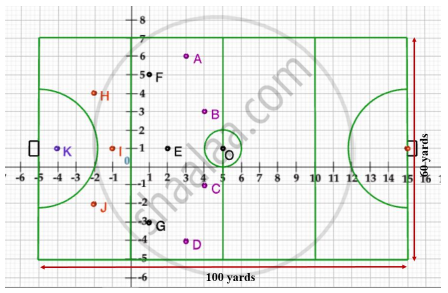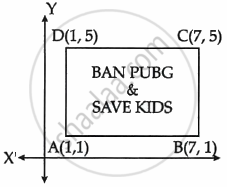Advertisements
Advertisements
प्रश्न
Show that the points (0, –1), (8, 3), (6, 7) and (– 2, 3) are vertices of a rectangle.
उत्तर
Let the points be P(0, –1), Q(8, 3), R(6, 7), S(–2, 3)
Distance between two points= `sqrt((x_2 - x_1)^2 + (y_2 - y_1)^2`
∴ By distance formula,
d(P, Q) = `sqrt((8 - 0)^2 + [3 - (-1)]^2`
= `sqrt((8 - 0)^2 + (3 + 1)^2`
= `sqrt(8^2 + 4^2)`
= `sqrt(64 + 16)`
= `sqrt(80)` ......(i)
d(Q, R) = `sqrt((6 - 8)^2 + (7 - 3)^2`
= `sqrt((-2)^2 + (4)^2`
= `sqrt(4 + 16)`
= `sqrt(20)` ......(ii)
d(R, S) = `sqrt([(-2) - 6]^2 + (3 - 7)^2`
= `sqrt((-8)^2 + (-4)^2`
= `sqrt(64 + 16)`
=`sqrt(80)` ......(iii)
d(P, S) = `sqrt([(-2) - 0]^2 + [3 - (-1)^2]`
= `sqrt((-2)^2+ (3+ 1)^2`
= `sqrt((-2)^2 + 4^2`
= `sqrt(4 + 16)`
= `sqrt(20)` ......(iv)
In ▢PQRS,
∴ side PQ = side RS .......[From (i) and (iii)]
side QR = side PS ......[From (ii) and (iv)]
∴ ▢PQRS is a parallelogram ......[A quadrilateral is a parallelogram, if both the pairs of its opposite sides are congruent]
d(P, R) = `sqrt((6 - 0)^2 + [7 - (-1)]^2`
= `sqrt((6 - 0)^2 + (7 + 1)^2`
= `sqrt(6^2 + 8^2)`
= `sqrt(36 + 64)`
= `sqrt(100)`
= 10 ......(iv)
d(Q, S) = `sqrt([(-2) - 8]^2 + [3 - 3]^2`
= `sqrt((-10)^2 + (0)^2`
= `sqrt(100 + 0)`
= `sqrt(100)`
= 10 ......(vi)
In parallelogram PQRS,
PR = QS .......[From (v) and (vi)]
∴ ▢PQRS is a rectangle. .......[A parallelogram is a rectangle if its diagonals are equal]
APPEARS IN
संबंधित प्रश्न
If A(4, 3), B(-1, y) and C(3, 4) are the vertices of a right triangle ABC, right-angled at A, then find the value of y.
Name the type of quadrilateral formed, if any, by the following point, and give reasons for your answer:
(4, 5), (7, 6), (4, 3), (1, 2)
If the distance between the points (4, k) and (1, 0) is 5, then what can be the possible values of k?
Find the distance between the points
A(1,-3) and B(4,-6)
Find the distance of the following point from the origin :
(0 , 11)
Find the distance between the following point :
(sin θ , cos θ) and (cos θ , - sin θ)
Prove that the points (0,3) , (4,3) and `(2, 3+2sqrt 3)` are the vertices of an equilateral triangle.
Prove that the points (4 , 6) , (- 1 , 5) , (- 2, 0) and (3 , 1) are the vertices of a rhombus.
A point P lies on the x-axis and another point Q lies on the y-axis.
Write the ordinate of point P.
The points A (3, 0), B (a, -2) and C (4, -1) are the vertices of triangle ABC right angled at vertex A. Find the value of a.
Find the distance of the following points from origin.
(5, 6)
Show that the points (a, a), (-a, -a) and `(-asqrt(3), asqrt(3))` are the vertices of an equilateral triangle.
The distance between the point P(1, 4) and Q(4, 0) is ______.
Case Study -2
A hockey field is the playing surface for the game of hockey. Historically, the game was played on natural turf (grass) but nowadays it is predominantly played on an artificial turf.
It is rectangular in shape - 100 yards by 60 yards. Goals consist of two upright posts placed equidistant from the centre of the backline, joined at the top by a horizontal crossbar. The inner edges of the posts must be 3.66 metres (4 yards) apart, and the lower edge of the crossbar must be 2.14 metres (7 feet) above the ground.
Each team plays with 11 players on the field during the game including the goalie. Positions you might play include -
- Forward: As shown by players A, B, C and D.
- Midfielders: As shown by players E, F and G.
- Fullbacks: As shown by players H, I and J.
- Goalie: As shown by player K.
Using the picture of a hockey field below, answer the questions that follow:

The coordinates of the centroid of ΔEHJ are ______.
Case Study -2
A hockey field is the playing surface for the game of hockey. Historically, the game was played on natural turf (grass) but nowadays it is predominantly played on an artificial turf.
It is rectangular in shape - 100 yards by 60 yards. Goals consist of two upright posts placed equidistant from the centre of the backline, joined at the top by a horizontal crossbar. The inner edges of the posts must be 3.66 metres (4 yards) apart, and the lower edge of the crossbar must be 2.14 metres (7 feet) above the ground.
Each team plays with 11 players on the field during the game including the goalie. Positions you might play include -
- Forward: As shown by players A, B, C and D.
- Midfielders: As shown by players E, F and G.
- Fullbacks: As shown by players H, I and J.
- Goalie: As shown by player K.
Using the picture of a hockey field below, answer the questions that follow:

The point on x axis equidistant from I and E is ______.
Find the value of a, if the distance between the points A(–3, –14) and B(a, –5) is 9 units.
What is the distance of the point (– 5, 4) from the origin?
Read the following passage:
|
Use of mobile screen for long hours makes your eye sight weak and give you headaches. Children who are addicted to play "PUBG" can get easily stressed out. To raise social awareness about ill effects of playing PUBG, a school decided to start 'BAN PUBG' campaign, in which students are asked to prepare campaign board in the shape of a rectangle: One such campaign board made by class X student of the school is shown in the figure.
|
Based on the above information, answer the following questions:
- Find the coordinates of the point of intersection of diagonals AC and BD.
- Find the length of the diagonal AC.
-
- Find the area of the campaign Board ABCD.
OR - Find the ratio of the length of side AB to the length of the diagonal AC.
- Find the area of the campaign Board ABCD.
The distance of the point (5, 0) from the origin is ______.

